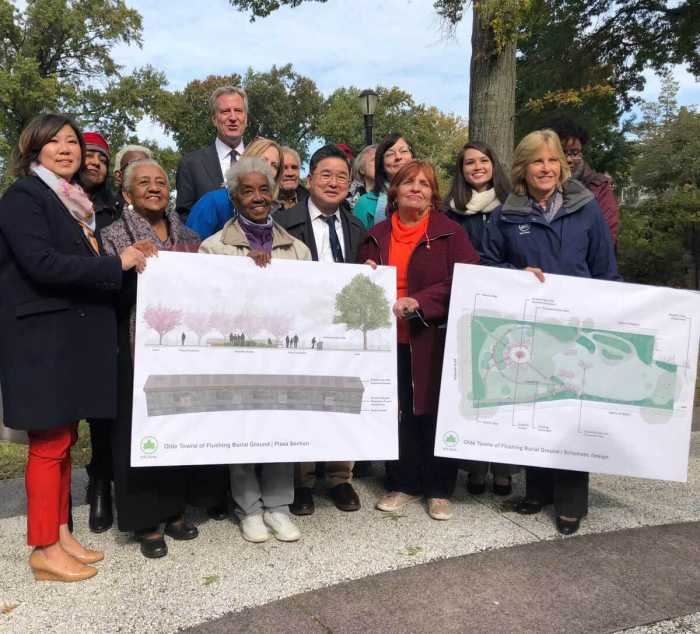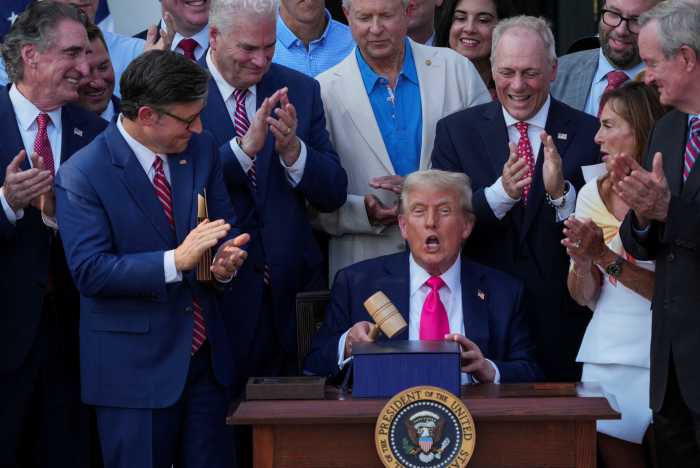By Carlotta Mohamed
Mayor Bill de Blasio joined Borough President Melinda Katz, along with local elected officials and community members last week unveiled designs of a $1.63 million project to reconstruct a commemorative plaza at the site of The Old Towne of Flushing Burial Ground.
“As Queens Week draws to an end, we’re commemorating an important part of our history and the vision of this community, which worked hard to get recognition for this site,” de Blasio said Oct. 26 at the burial ground, located at 46th Avenue between 164th and 165th Street.
The restoration project received unanimous approval Oct. 22 from Community Board 7 for the city Parks Department to reconstruct 1.6 acres of the 3.5 acre burial site, where nearly 1,000 Native-Americans and African-Americans were buried in the 1800s.
The new design features a memorial wall for the 399 known names and will highlight four individuals whose families had purchased marble headstones in the 19th century. The Works Progress Administration workers destroyed the headstone during the 1930s when they turned the surface of the burial ground into a recreational site under Parks Commissioner Robert Moses.
After years of advocating for recognition to memorialize and honor those buried at the site, members of the Old Towne of Flushing Burial Ground Conservancy believe the site is a large part of Flushing history.
The site is now listed on the New York State and National Registry of Historic Places, according to Robbie Garrison, co-chair of The Olde Towne of Flushing Burial Ground Conservancy.
“Native-Americans and African-Americans have been in Flushing since Queens was established,” Garrison said. “This will be a teaching site as well as a long-needed memorial to the forgotten souls interred here and so long disrespected.”
According to the conservancy, the community didn’t recognize the site as a cemetery and used it for inappropriate activities, such as ignoring the “no dogs allowed” sign and holding sports practices.
In November 2006, community activist Mandingo Tshaka, who had been fighting for recognition for more than a decade alongside former City Councilman and Comptroller John Liu, reclaimed the site, relocating the playground to the northern end. A ground-level plaque was installed to commemorate those buried there.
The Parks Department’s new design includes a commemorative plaza, reconstructed pathways to provide better circulation throughout the site and an interpretative sign to provide historic information.
A butterfly garden will be added with new benches and plantings to create an area of tranquility for all visitors, surrounded by cardinal directions written in a local Native-American Language.
The project is slated to be completed in 2020.
“We are thrilled that this project is coming to fruition with today’s design unveiling. We are happy with the design, which honors the people that are interred here and have never been acknowledged before,” said Eugene Kelty Jr., chair of Queens Community Board 7.
The design, scheduled to go before the Public Design Commission in November, was created in consultation with local community members and the Old Towne of Flushing Burial Ground. It received $1.62 million in funding, including $600,000 from Katz, $520,000 from City Councilman Peter Koo (D-Flushing) and an additional $500,000 from de Blasio.
In the 1990s, when the Parks Department began a renovation of the site, Tshaka drew attention to its previous history. In response, Parks commissioned a $50,000 archeological study in 1996. Archeologist Linda Stone concluded that the site served as the final resting place for between 500 to 1,000 individuals.
According to the Parks Department, death records for the town of Flushing existed from the period of 1881 until 1898, revealing 62 percent of the buried were African American or Native American, 34 percent were unidentified, and more than half were children under the age of 5.
“The Olde Towne of Flushing Burial Ground is a hidden gem in our community that has been deprived of the recognition it deserves for decades,” said Koo. “With this memorial, we let the bones beneath our feet know that times have changed and the disrespect and dishonor they received in life no longer carries over into death.”
Reach reporter Carlotta Mohamed by e-mail at cmoha









































